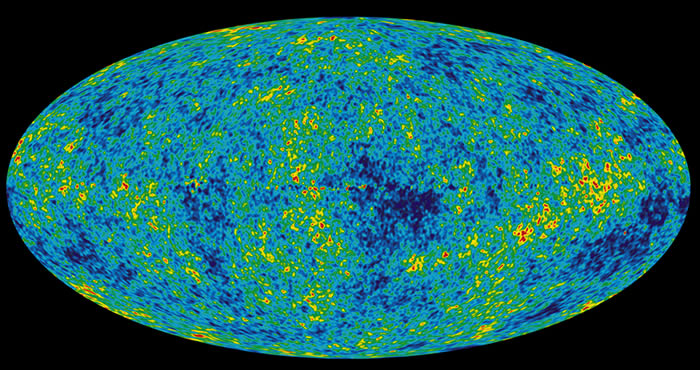Cosmic Microwave Background Radiation
16.8 - Understand the major observational evidence in favour of the Big Bang theory:b) cosmic microwave background (CMB) radiation
16.9 - Understand the significance of the fluctuations in the CMB radiation for theories of the evolution of the Universe, including discoveries by the Wilkinson Microwave Anisotropy Probe (WMAP) and the Planck mission
The CMB is the furthest (and therefore, oldest) signal detected by a telescope. The temperature is a cold 2.7°K (-273.3°C). The slight variations in temperature, as seen in the image, are very small.
The CMB is the heat remnant of the Big Bang, the background temperature of the Universe.
To our eyes (and telescopes) space appears black, but to a sensitively calibrated radio telescope, a background glow appears. This is consistent in any direction with very minor variations in density - the apparent ‘ripples’ in the radiation.
As the heat and plasma from the Big Bang expanded, the Universe became transparent and the radiation cooled to its present temperature. Big Bang models show that early growth in the first fractions of a second smoothed out irregularities and what is visible are miniscule fluctuations at a quantum level.
Discovery
CMB was theorised before it was discovered. With the formation of the Big Bang theory, the question arose as to what happened to all the heat in the Universe from that time.
From the mid 1940s to the mid 1960s, various scientists theorised of the temperature of the Universe and its form. There were estimates to within a fair degree of accuracy.
In 1964, Arno Penzias and Robert Wilson at Bell Labs worked on a sensitive 6 metre 'horn antenna' radio telescope. They eliminated all known radio waves but still detected a faint but consistent noise. it was spread throughout the sky and did not change throughout the day. The wavelength they worked on did not come from the Milky Way, but from outside the galaxy.
Princeton University scientists were working on detecting microwaves left over from the Big Bang. When they heard about Penzias and Wilson, the two sets of research produced proof of the CMB.
Observations & Significance
- Between 1989–1996 the NASA Cosmic Background Explorer (COBE) satellite made an extensive survey of the CMB.
- In 2001 NASA launched WMAP, the Wilkinson Microwave Anisotropy Probe to take even more accurate measurements (see below).
- In 2009 ESA launched the Planck Surveyor to further study the CMB. In addition extensive ground-based observations continue studies.
The WMAP Home page at https://wmap.gsfc.nasa.gov/ lists several of its important achievements to date. The below text is quoted from this page:
- NASA's Wilkinson Microwave Anisotropy Probe (WMAP) has mapped the Cosmic Microwave Background (CMB) radiation (the oldest light in the Universe) and produced the first fine-resolution (0.2 degree) full-sky map of the microwave sky
- WMAP definitively determined the age of the Universe to be 13.73 billion years old to within 1% (0.12 billion years) -as recognized in the Guinness Book of World Records!
- WMAP's complete census of the Universe finds that dark matter (not made up of atoms) make up 23.3% (to within 1.3%)
- WMAP's accuracy and precision determined that dark energy makes up 72.1% of the Universe (to within 1.5%), causing the expansion rate of the Universe to speed up. - "Lingering doubts about the existence of dark energy and the composition of the Universe dissolved when the WMAP satellite took the most detailed picture ever of the cosmic microwave background (CMB)." - Science Magazine 2003, "Breakthrough of the Year" article
- WMAP has started to sort through the possibilities of what transpired in the first trillionth of a trillionth of a second, ruling out well-known textbook models for the first time.
Planck was a space observatory operated by the European Space Agency from 2009 to 2013. It measured the average density of ordinary matter and dark matter in the Universe and the age of the universe.
Did you know?
1% of the static grey noise your television picks up when not tuned in is from the CMB.
Questions
- What is the CBM?
- How was it discovered?
- What does it tell us about how the Universe was formed?
- What is its temperature?
Links
- WMAP's Universe - The CMB
- Planck Mission
- PBS - Penzias and Wilson discover cosmic microwave radiation


 | © All Rights Reserved |
| © All Rights Reserved |